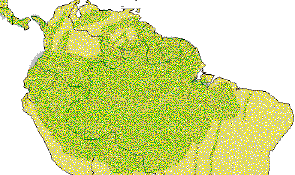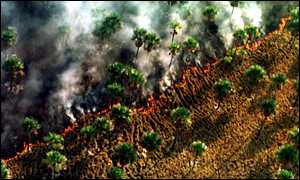
Location of the Amazon forest
Source: http://www.geog.umn.edu/~schaller/Amazon/rainforest/rainforest2.html
The Amazon forest is source of great biodiversity and goods, which is really important for human being. It contains the “biggest and richest primeval forest in the world” and it represents more than 50% of the world’s rainforest, according to The Rape of the Amazon. The Amazon forest is “the most powerful and bio-actively diverse natural phenomenon of the planet” (Taylor). Plant diversity, as well as animal diversity, is very important for human being because there are many species we can use for our own benefit (Tuxill & Bright, 1998). It is source of essential genes for crops and livestock, pollination, biological control, cleaning water and regeneration of soil (Tuxill & Bright, 1998). Biodiversity includes genes, species and ecosystems.

Location of the Amazon forest
Source: http://www.geog.umn.edu/~schaller/Amazon/rainforest/rainforest2.html
However, thousand of hectares are being destroyed every year by shifting
cultivation and logging companies. According to Taylor, the Amazon deforestation
is around 20,000 square miles a year, which means an increase of more than
three times since 1994.
The Amazon forest gives to human being several benefits. If we use the
forest appropriately we can have an enormous source of timber and non-timber
products for long period of time. Biodiversity is essential for human existence
Forest products are important not only for industries but also for the
communities who live around or inside the forest. Several indigenous group
of people lives in the forest, using it as shelter and source of food (Hellen).

The Amazon rainforest
Source: http://www.rain-tree.com/facts.htm
The cure of cancer or AIDS could be in the Amazon forest. From rain forest every year exotic plants to develop vaccines or cure for people is taken. According to Tuxill & Bright, (1998), 25% of the medicine used in the United States has chemical which come from wildlife and billions of rural people use plant and animal as natural medicine. Taylor reports that in the USA the sales of plant-base drugs were around $4.5 billion in 1980 and $40 billion in 1990 for worldwide. Dr. Varro E. Taylor, a pharmacognosist, cited by Morgan (1997), says that two-thirds of the modern medicine comes from plants in general, which can give us an idea of the of the amazon forest importance, considering that it represents 54% of the planet’s rain forest (Taylor).
However, despite these reasons widely known for preserving the Amazon,
logging companies and shifting cultivation are destroying the Amazon forest.
According to Taylor, logging for wood exportation “is the single largest caused of rainforest destruction”, in addition to the production of fuel wood and charcoal and paper. He shows the Amazon case as prove of the logging destruction effect.
There are many valuable wood species, very appreciated by the logging
companies, many of them associated to other harvesting activities. Bruno
Manser-Fonds (1998) reports that many corporation, such Nestle, Pirelly,
Mitsubichi and Marubeny, are responsible for deforestation and migration
in the Amazon, because of their large-scale of logging and other activities
(such oil palm and rubber plantation). Just in the Brazilian Amazon, one
of the nine Amazon countries, in 1997 around 623,000 cubic meters of wood
were harvested, according to Freeman (1998). This author reports
that in 1995 in the Brazilian Amazon loggers affected 11,600 square miles
(almost the size of Belgium) and in 1996 about 7,625 square miles.
Logging companies are not only destroying the forest, but also are
affecting the indigenous people rights, invading their lands and reserves.
After logging, those people are poorer because their forest have been deteriorate
and its richness taken.
Forest harvesting can destroy forest or can conserve it. Several researchers think that the solution for the Amazon destruction is to implement appropriated logging methods as well as sustainable agricultural practices (Walker, 1996). The Brazilian Government now is ready to give to logging companies around 2.67 million hectares of public forest, in order to prove that good logging practices can both protects forest and support local communities (Brazil picks Amazon site for sustainable logging, 1998).
Logging does not bring deforestation immediately. It first effect
is on the abundance of valuable timber, impact on the health of the ecosystem
(because of the logging itself) and fauna. Usually, loggers don’t bring
their own meat. They hunt animals which affects the wildlife population
and so the meat availability for the local people. Once there are no more
valuable tree species, loggers leave the forest and small farmers come
using the
logging roads and clear the forest for shifting cultivation.

A Yanomani woman.
Source: http://news.bbc.co.uk/hi/english/world/americas/newsid_85000/85627.stm
The main problem in the Amazon deforestation is the shifting cultivation caused by settlements (Murphy; Bilsborrow & Pichon, 1997). Hundred of thousands of small farmers without lands have taken the forest replacing for agriculture crops.
According to Time International (1998), burning (and logging) is destroying the Brazilian Amazon. By 1995 12.9% of the forest was cleared, despite of the new legislation that imposes fines and jail for illegal forest activities. On the other hand, Cauduro Dias de Paiva & Clarke (1995), referring t a 30-year-period record, shows that there were negative trends of deforestation in western and central Amazon and more positive trends in the eastern region.
Many times, because of lack of knowledge and economical and political interests, official government programs support colonization. Governments have made many mistakes on conservation policy (Dietz & Stern, 1998). They have usually supported colonization programs to reduce the people pressure for land, which has brought as result deforestation; although, the Amazon colonization is more spontaneous rather than planed

Fire in the forest
Source: http://news.bbc.co.uk/hi/english/world/americas/newsid_85000/85627.stm
The Amazon colonization has began in the 1950s and reached its highest levels between 1970 and 1980, especially in Brazil where the construction of new roads and forest exploitation promoted a big-scale spontaneous colonization (Murphy, Bilsborrow & Pichon, 1997). With the Brazilian Government support, since 1970 more than three million poor people without any land were moved to the Brazilian Amazon forest, who discovered too late that the soil was infertile (The rape of the Amazon).
In spite of the fact that the ecological cost for production is high,
in general the setters they are poor comparing with some prospering ranchers,
because settlers own poor soils and cultivate crops just for subsistence
proposes (Murphy, Bilsborrow & Pichon, 1997).
The Amazon forest is a fantastic source of biodiversity, timber and non-timber products, food and shelter for indigenous people. There are enough reasons to conserve the Amazon forest.
Unfortunately, bad logging practices and insufficient forest administration occurs not only in the Amazon forest, but also in other tropical regions, as Nik Sekhran (1997) has found in his good article “Green or greed (Industrial logging in Papua New Guinea)”. Sekhran shows that in Papua New Guinea commercial exploitation is affecting the biodiversity but native tribal groups are not well prepare to stop it, the same as in the Amazon region. Although forest exploitation is one mayor reason for the Amazon deforestation, logging companies are still there. It seems to be quite impossible to stop these companies.
They have power and, in some case the government protection. So, what
should be done?
Logging companies should be obligated to implement sustainable forest
management plans, in order to conserve the forest they are using. It is
also necessary that logging companies respect the right of indigenous people
and, if possible, to involve them in the forest operation. No forest exploitation
should be allowed into indigenous lands without permission and/or participation
of the native people in order to avoid social confrontation and injustices
with the local people.
Regarding to shifting cultivation, the main problem is that it is quite
impossible for any government to stop invasion to forest, unless they give
lands or better life condition for those poor people. Instead of moving
people to the Amazon, it should be better to help them in their original
places, giving to them better life condition, credits, technical assistance,
health service and education.
Once people are settled in the forest, it is almost impossible to move them. When this is the fact, it seems that there is no other option than helping them, implementing sustainable projects such as sustainable agriculture (Walker, 1996), ecotourism (Hendrix, 1997) and community forest management, although some people don’t agree with these kinds of projects. Raloff (1997), says that programs implemented in tropical areas in order to help communities, like ecotourism, nut harvesting, etc, fail because they don’t consider the environmental impacts of such activities on soil conservation. However, it is really hard to implement a productive activity in the forest without any environmental impact. The question is which activity gives more benefit in terms of sustainable development, considering acceptable impacts. That may be the case of the Amazonic Madidi National Park project in Bolivia (Hendrik, 1997), where a $1.8-millon-project is implemented in order to carry out a social ecotourism initiative, that considers forest conservation.
Few people are against the use of the Amazon, but it must be in a right way, implementing sustainable practices, signing and honoring agreements with the local people. Governments should develop policies to support and give assistance to poor people in their home places in order to stop migration to the Amazon.
Extinction is forever.
Asia's crisis benefits Brazilian rainforests. (1998). Wood Technology, 125 (5), 12.
Brazil picks Amazon site for sustainable logging. (1998). Wood Technology, 125 (5), 13.
Canduro Dias de Payva, E.M. & Clarke, R.T. (1995). Time trends in rainfall records in Amazonia. Bulletin of the American Meteorological Society. 76(11), 2209.
Dietz, T & Stern, P.C. (1998). Science, values, and biodiversity. BioScience, 48 (6), 441-444.
Egan, K. (1996). Forging new alliances in Ecuador's Amazon. SAIS Review, 16 (2), 123-142.
Hendrix, S. (1997). Bolivia’s outpost of hope. International Wildlife, 27(1), 19
Manser-Fonds, B. (1998). Why are forests burning? The Ecologist, 28 (1), 8.
Morgan, P. (1997). The pasha of plants. Prevention, 49 (1), 70.
Murphy, L.; Bilsborrow, R & Pichon, F. (1997). Poverty and prosperity among migrant settlers in the Amazon rainforest frontier of Ecuador. Journal of Development Studies, 34(2), 65.
Raloff, J. (1997). Erosion tails tropical trails. Science News, 151(8), 124.
Sekhran, N. (1997). Green or greed. Geographical Magazine, 69 (10), 75-81.
Taylor, L. (No date). Saving the Rainforest. A complex Problem. Available
HTTP: http://www.rain-tree.com/facts.htm [1998, 5 August].
The Rape of the Amazon. (No date). Available HTTP: http://www.sol.com.sg/edufarm/members/voyager/GTA/amaz.html
[1998, 6 August].
Time International (1998). Satellite data show slower rate of destruction
of Amazon rain forest in Brazil. Time Inc. 150(24), 10.
Tuxill, J. & Brigh, C. (1998). Protecting nature's diversity: mending strands in the web of life. The Futurist, 32(5), 46-51.
Walker, G. (1996). Slash & grow. (The Amazon). New Scientist, 151(2048),
33